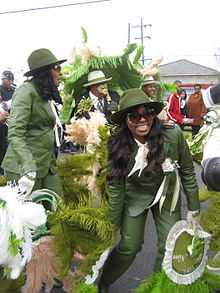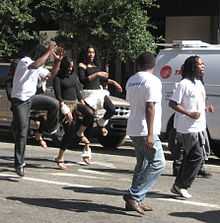Second line (parades)




Second line is a tradition in brass band parades in New Orleans, Louisiana. The "main line" or "first line" is the main section of the parade, or the members of the actual club with the parading permit as well as the brass band. Those who follow the band just to enjoy the music are called the "second line." The second line's style of traditional dance, in which participants walk and sometimes twirl a parasol or handkerchief in the air, is called "second lining." It has been called "the quintessential New Orleans art form – a jazz funeral without a body."[1] Another significant difference from so called "jazz funerals" is second line parades usually lack the slow hymns and dirges played at funerals (although this is not a hard rule; some organizations may have the band play something solemn towards the start of the parade in memory of members deceased since their last parade).
Origins
Some scholars believe that second lining has its origins in traditional West African circle dances, where children formed a periphery circle outside the main circle of adult dancers. The dance was brought by slaves to New Orleans, where it became incorporated into processions, such as funerals, forcing the ring to straighten into a line.[2] Others note the similarity of the steps – exaggerated, loosely coordinated strutting – to dances performed in Congo Square by the enslaved given the day off on Sundays. These dances were officially banned for a time because they were deemed threatening to the white inhabitants of the city, and their resurgence in second lining suggests a similar celebration of individual freedom.[3]
After the Civil War, African and African-American traditions merged with brass bands. Insurance companies often refused to cover the recently freed formerly enslaved, so African Americans formed into Benevolent Societies and "Social Aid & Pleasure Clubs". Membership benefits usually included a brass band for funerals and at least one public parade with music a year, so such societies became important in establishing the second line traditions.
The Second Line – the magazine of the New Orleans jazz club, started in 1950 – took its name from the second lining tradition, which by that time included fans of jazz music, both black and white.[4]
Modern second lining
Second line parades are part of the cultural heritage of New Orleans.
The locally best known second line parades are held by clubs and benevolent organizations. Some have long histories; the oldest such organization still holding regular parades is the Young Men Olympian Junior Benevolent Association, founded in 1884. During the "second line season", lasting most of the year with breaks for holidays (including Mardi Gras) and the hottest part of summer, there are second line parades most Sundays.[5] Longer parades often make stops, commonly at bars, where refreshments have been arranged for members and those following the parade for fun can purchase something. There are often vendors selling soft drinks, beer, and street food, including barbecue and yaka mein.
Additional second lines, large or small, may be held for any event which people think merits hiring a parading band for such a style of celebration, including weddings and opening of businesses.
The historic predominantly African-American neighborhoods of Tremé and Central City are most strongly associated with the traditions, though second lines can often be seen in the Seventh Ward, Uptown, Marigny, Ninth Ward, Mid-City, and at least on occasion in most of the older neighborhoods of the city. The New Orleans Jazz & Heritage Festival holds second lines at the Fair Grounds each day of the festival to give visitors a taste of this New Orleans tradition.
Historically, the parades were unofficial events and had an air of menace[citation needed]. The HBO series Treme introduced the general public to second line parades [citation needed], and journalists championed second line culture[citation needed]. After Hurricane Katrina, new residents of New Orleans embraced the second line tradition and it became part of the cultural economy of the city[citation needed]. Parade routes were publicized online inviting outsiders to participate.[6]
The overwhelming majority of second line events have been peaceful, but like any other public event where large numbers of people gather, violence has marred some parades in recent years, most notoriously in the 2013 Mother's Day Parade shooting.
Other places
Though originally a New Orleans phenomenon, in recent times the style has spread to other parts of the country. Still, second lining remains most common in the New Orleans area.
References
- ↑ Baum, Dan. Nine Lives: Death and Life in New Orleans (Spiegel & Grau, 2009), p. 120.
- ↑ Richard Brent Turner (11 August 2009). Jazz religion, the second line, and Black New Orleans. Indiana University Press. p. 108. ISBN 978-0-253-22120-9. Retrieved 30 October 2011.
- ↑ Roger D. Abrahams (2006). Blues for New Orleans: Mardi Gras and America's Creole soul. University of Pennsylvania Press. pp. 31–2. ISBN 978-0-8122-3959-1. Retrieved 30 October 2011.
- ↑ Martin Halliwell (15 March 2007). American culture in the 1950s. Edinburgh University Press. pp. 140–1. ISBN 978-0-7486-1885-9. Retrieved 6 November 2011.
- ↑ http://www.bestofneworleans.com/blogofneworleans/archives/2011/08/23/tis-the-season-for-second-line-parades
- ↑ "Celebrating, in Spite of the Risk". NY Times. May 14, 2013. Retrieved May 14, 2013.
External links
| Wikimedia Commons has media related to Second lines. |
- Nick Spitzer, "Rebuilding the 'Land of Dreams:' Expressive Culture and New Orleans' Authentic Future" Southern Spaces, 29 August 2006
- Nick Spitzer, "Love and Death at Second Line" Southern Spaces, 20 February 2004.
- A Jazz Funeral – including pictures of second-liners
- Jazz Times: New Orleans’ Second Lines
- The New Orleans Jazz Club
- Mardi Gras Digest: History of the Secondline
| |||||
| |||||||||||||||||